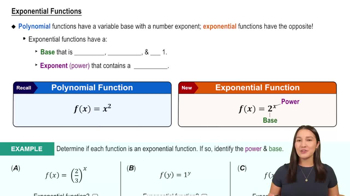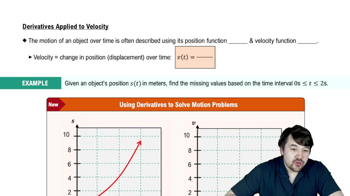A pen in the shape of an isosceles right triangle with legs of length x ft and hypotenuse of length h ft is to be built. If fencing costs \$5/ft for the legs and \$10/ft for the hypotenuse, write the total cost C of construction as a function of h.
Table of contents
- 0. Functions7h 54m
- Introduction to Functions16m
- Piecewise Functions10m
- Properties of Functions9m
- Common Functions1h 8m
- Transformations5m
- Combining Functions27m
- Exponent rules32m
- Exponential Functions28m
- Logarithmic Functions24m
- Properties of Logarithms36m
- Exponential & Logarithmic Equations35m
- Introduction to Trigonometric Functions38m
- Graphs of Trigonometric Functions44m
- Trigonometric Identities47m
- Inverse Trigonometric Functions48m
- 1. Limits and Continuity2h 2m
- 2. Intro to Derivatives1h 33m
- 3. Techniques of Differentiation3h 18m
- 4. Applications of Derivatives2h 38m
- 5. Graphical Applications of Derivatives6h 2m
- 6. Derivatives of Inverse, Exponential, & Logarithmic Functions2h 37m
- 7. Antiderivatives & Indefinite Integrals1h 26m
- 8. Definite Integrals4h 44m
- 9. Graphical Applications of Integrals2h 27m
- 10. Physics Applications of Integrals 3h 16m
- 11. Integrals of Inverse, Exponential, & Logarithmic Functions2h 31m
- 12. Techniques of Integration7h 41m
- 13. Intro to Differential Equations2h 55m
- 14. Sequences & Series5h 36m
- 15. Power Series2h 19m
- 16. Parametric Equations & Polar Coordinates7h 58m
0. Functions
Common Functions
Problem 1.1.54
Textbook Question
Even and Odd Functions
In Exercises 47–62, say whether the function is even, odd, or neither. Give reasons for your answer.
g(x) = x/(x² − 1)
 Verified step by step guidance
Verified step by step guidance1
To determine if a function is even, odd, or neither, we need to evaluate the function at -x and compare it to the original function g(x).
Calculate g(-x) by substituting -x into the function: g(-x) = (-x)/((-x)² - 1).
Simplify g(-x): Since (-x)² = x², we have g(-x) = -x/(x² - 1).
Compare g(-x) with g(x): g(x) = x/(x² - 1) and g(-x) = -x/(x² - 1). Notice that g(-x) = -g(x).
Since g(-x) = -g(x), the function g(x) is odd. A function is odd if g(-x) = -g(x) for all x in the domain of the function.
 Verified video answer for a similar problem:
Verified video answer for a similar problem:This video solution was recommended by our tutors as helpful for the problem above
Video duration:
2mPlay a video:
Was this helpful?
Key Concepts
Here are the essential concepts you must grasp in order to answer the question correctly.
Even Functions
A function is classified as even if it satisfies the condition f(-x) = f(x) for all x in its domain. This means that the graph of an even function is symmetric with respect to the y-axis. A common example of an even function is f(x) = x², where substituting -x yields the same output as substituting x.
Recommended video:

Exponential Functions
Odd Functions
A function is considered odd if it meets the condition f(-x) = -f(x) for all x in its domain. This indicates that the graph of an odd function is symmetric with respect to the origin. An example of an odd function is f(x) = x³, where substituting -x results in the negative of the output for x.
Recommended video:

Properties of Functions
Function Analysis
Analyzing a function involves evaluating its behavior under transformations, such as substituting -x for x. This process helps determine whether the function is even, odd, or neither. For the function g(x) = x/(x² - 1), one must compute g(-x) and compare it to g(x) and -g(x) to classify its symmetry.
Recommended video:

Derivatives Applied To Velocity

 5:57m
5:57mWatch next
Master Graphs of Common Functions with a bite sized video explanation from Patrick
Start learningRelated Videos
Related Practice
Textbook Question
